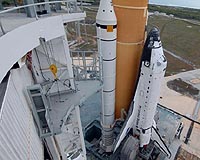 |
Washington (AFP) Nov 21, 2009 Shuttle Atlantis astronauts on Saturday completed the second of their mission's three spacewalks to maintain and install more high-tech gadgets on the International Space Station. The sortie was delayed by over an hour after false depressurization alarms earlier rang through the orbiting outpost and jolted mission specialists Mike Foreman and Randy Bresnik awake after just two hours of sleep, rattling preparations. Bresnik, venturing out into space for the first time, was most likely already restless as he awaited the birth of his daughter back on earth. His wife Rebbeca Burgin was due to give birth to the couple's second child on Friday. If the baby is born during the Atlantis mission, Bresnik would be only the second person to become a father in space. But he was forced to set aside family concerns and concentrate on the task at hand, as the second exterior work effort of the shuttle's 11-day mission got underway more than an hour late, at 1431 GMT. It was shortened by about 30 minutes due to the false alarms, but the duo completed all their scheduled tasks during the six-hour, eight-minute spacewalk which ended at 1939 GMT, said US space agency NASA. "Congratulations on another amazing day of work in space," mission specialist Megan McArthur told the astronauts from mission control in Houston, Texas. The pair installed a cargo attachment system on the space-facing side of the station's Starboard 3 truss and set up a wireless video system to transmit images to the station and relay them to Earth. During a separate mission next year, the Alpha Magnetic Spectrometer will be installed at the attachment point. Foreman and Bresnik also tackled a task that had been planned for the third spacewalk -- deploying the final attachment system on the Earth-facing side of the truss, where a logistics carrier will be installed next year. In addition, they installed two antennas on a Columbus European lab assembly to track ships on Earth, and relocated a floating unit that measures electric charges on the station. Prior to the spacewalk, two other astronauts used the station's robotic arm to transfer a cargo pallet containing 10,000 pounds (4,545 kilograms) of spare parts. The false depressurization and smoke alarms had sounded around 0253 GMT, forcing Bresnik and Foreman to exit the Quest airlock, where astronauts "camp out" before spacewalks to purge nitrogen from their bloodstream to prevent decompression sickness. The alarm originated from the Russian Poisk Mini-Research Module -- which astronauts delivered to the ISS on November 12 -- with the station's automatic response shutting down ventilation systems, thus setting off two smoke detectors. It took about an hour for conditions to return to normal. After Atlantis, just six space missions will remain in the shuttle program before the fleet's three orbiters are retired. NASA's shuttle program is due to be mothballed next year, but the White House could still decide to extend it through 2011 to reduce America's future reliance on Russia for transporting astronauts to the space station. The shuttle remains the only spacecraft that can carry heavy, bulky equipment that is key to maintaining the ISS, itself set to remain operational until 2020. Sixteen countries participate in the ISS program, at a cost of 100 billion dollars with most financing coming from the United States. The US human space flight program, which swallows up 10 billion dollars of NASA's 18-billion-dollar annual budget, is at great risk of being grounded. A panel set up by President Barack Obama and tasked with assessing its future has said an additional three billion dollars per year is needed for NASA to meet its goals. Share This Article With Planet Earth
Related Links Shuttle at NASA Watch NASA TV via Space.TV Space Shuttle News at Space-Travel.Com
 LockMart Tests Carbon Nanotube-Based Memory Devices On Shuttle
LockMart Tests Carbon Nanotube-Based Memory Devices On ShuttlePalo Alto CA (SPX) Nov 20, 2009 A radiation-resistant version of NRAM carbon-nanotube-based memory, developed jointly by Lockheed Martin and Nantero, was tested on a recent Space Shuttle mission. The NRAM was incorporated by NASA into special autonomous testing configurations installed into a carrier at the aft end of the payload bay. It was launched into space as part of STS-125, the May 2009 mission of the Space Shuttl ... read more |
|
| The content herein, unless otherwise known to be public domain, are Copyright 1995-2009 - SpaceDaily. AFP and UPI Wire Stories are copyright Agence France-Presse and United Press International. ESA Portal Reports are copyright European Space Agency. All NASA sourced material is public domain. Additional copyrights may apply in whole or part to other bona fide parties. Advertising does not imply endorsement,agreement or approval of any opinions, statements or information provided by SpaceDaily on any Web page published or hosted by SpaceDaily. Privacy Statement |